Introduction: Business Understanding
National Health Service (NHS) Trust Overview
Amid the impacts of COVID-19 worldwide, the NHS is more than dedicated to ensuring England residents live healthier lives. This aligns with the vision statement “enabling people to live healthier and more independent lives through high-quality seamless care.” Years after the first positive COVID-19 case, the world went into shock, with many people becoming confused and worried about the virus. Without a sure vaccine, NHS decided to make it its goal to improve COVID-19 response in England. At the moment, the trust is dedicated to taking smaller steps towards reducing the spread of the vaccine while the larger NHS focuses on the treatments and vaccine administration.
Current Problem
Although current vaccination drives prove to offer some relief to England citizens, much research is still needed to develop a vaccine that would improve the resistance to the vaccine. This is especially evident due to the continued mortality rates, even for vaccinated patients, making it important to develop other mitigation measures. The trust believes that an effective alternative to prevent these cases from spiking is the introduction of non-medical interventions such as improved nutrition.
COVID-19 deaths globally are dependent on a single or multiple chronic conditions. Evidence suggests that older individuals are at a higher risk of negative outcomes with the pandemic (Li et al., 2020; Osama, Pankhania and Majeed, 2020). Although nutrition is not a proven approach to treating COVID-19, there are suggestive reports which indicate that it is a modifiable predictor of the development of chronic diseases, a significant determinant of COVID-19 severe illnesses and deaths (Butler and Barrientos, 2020). Multiple studies reveal the role of a balanced diet and healthy dietary patterns in strengthening the immune system, improving immuno-metabolism, and reducing the risk of chronic conditions (Bruins, Van Dael and Eggersdorfer, 2019; Caccialanza et al., 2020). This illustrates that nutrition can present both negative and positive effects on COVID-19. It may highlight assistive measures for higher-risk groups such as older people and those with underlying medical conditions (Muscogiuri, Barrea, Savastano and Colao, 2020).
These recommendations suggest the importance of nutritional optimization, which the NHS trust is currently focused on achieving. Recommendations should not be addressed to a single individual but everyone going through individual treatments such as personal quarantine. The overall NHS organization needs to know the benefits of healthy eating and provide England residents with a comprehensive nutritional guide for themselves and their loved ones, especially those at high-risk infection. Understanding the role of nutrition on COVID-19 outcomes may help people manage their conditions, even if they are diagnosed with the virus, and prevent the onset of chronic conditions that would translate to negative outcomes (Zhang and Liu, 2020).
Available global data highlights nutritional trends, including global protein (nutrient) and calorie intake. The data also includes the obesity and undernourishment levels and the COVID-19 prevalence and outcomes. This information is critical in understanding whether the global population understands the importance of nutrition even as the pandemic rages on and determining approaches to reduce negative outcomes by popularizing good nutritional habits.
Variable Formation
The datasets contain three dependent variables (deaths, recoveries, and cases) and three predictor variables (nutritional trends, malnutrition, and obesity). The aim is to identify the predictor variables responsible for COVID-19 outcomes that are significant for the predictor variables.
- Null hypothesis – No predictor can explain the COVID-19 outcomes.
- Alternate hypothesis – At least one of the predictor variables can explain the COVID-19 outcomes.
Data Understanding
There are 32 columns in the data with the names and 5440 entries. The data provides information about the nutritional habits of countries worldwide in knowing the prevalence of COVID-19 deaths. This information examines whether the rate of COVID-19 deaths is different between countries based on nutritional trends.
Data Cleaning
Data was loaded into Power BI for assessment and cleaning. This process was conducted concerning the aim of the study, which is to examine the role of nutritional trends, obesity, and malnourishment on COVID-19 cases, deaths, and recoveries. After importing the data, it was noticed that there were similar entries, and therefore the focus was put on a single dataset (Food_Supply_kcal_Data.csv). Data on different food types, national obesity, undernourished rates, and COVID-19 cases were combined with an overview of how healthy eating can help combat the pandemic. This step was also done to provide more information on the dietary patterns of different countries presenting lower infection rates. These findings were used to recommend that the NHS trust adjust the diet.
All numerical data types, except for population, were converted into decimal numbers (four decimal places). The data set included 23 food categories and was used to illustrate the foods which composed a single category to assess the impact of protein supply and fat quantity on COVID-19 outcomes. An evident observation was that some columns had NA values. To retain these, they were converted into zeros to make analysis easier and retain the sample size. Entries for the leading countries with higher obesity, death, and recovery rates were combined into an individual dataset. This new dataset included entries for the top 15 countries with higher entries in the defined variables.
Data used in this section encompassed fat quantity and protein quantity for various food categories calculated as percentages of total intake. The obesity rate compares nutrient intake on obesity and COVID-19 outcomes. Additionally, significant data included the current COVID-19 infections, deaths, and cases as population percentages. To have a clearer focus area, COVID-19 deaths and recoveries were used as response variables measured for the available countries.
The death rates formed the continuous response since the data is regularly updated. However, since the focus was on the current estimates, the zeros recorded to represent specific data and the positive continuous COVID-19 outcomes were not omitted. This information was vital for the study since the focus was on the positive responses, in which zero is a possibility.
Exploratory Data Analysis
The current section seeks to address the prevailing question on the role of nutrition and COVID-19 outcomes. Exploratory data analysis is preferred since it allows a researcher to provide an in-depth understanding of data through summary statistics and graphical visualizations. This is an ideal approach for performing preliminary data investigation to identify patterns, and anomalies, test hypotheses, and verify assumptions (Sahoo et al., 2019).

The above plot illustrates no linear relationship between the consumption of alcoholic beverages and the risk of COVID-19. An evident observation is a spike in mortality rates with an increase in consumption between 0.063 and 0.085, meaning that continued alcohol intake increases the risk of COVID-19. However, this is only an assumption, and the risk can be due to other conditions, such as the impact of alcohol on the body. Therefore, alcoholic beverages cannot be used to explain the COVID-19 outcomes.
Another focus was the consumption of animal fats and obesity, as illustrated in the figure below.
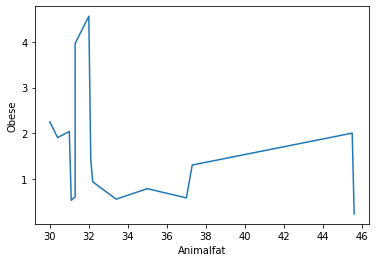
From the figure, there is also no clear correlation between animal products and obesity, meaning that the average energy spent by an individual can influence the risk of obesity, regardless of their diet. As a comparison, vegetable intake was examined to illustrate whether there would be different observations. From the figure, it is clear that vegetable intake can also increase the risk of obesity.
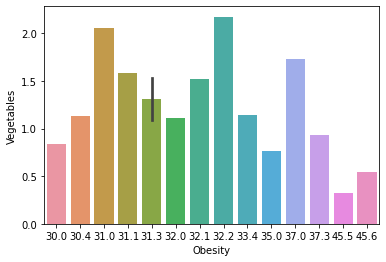
The following figure illustrates the food type which had a greater impact on promoting COVID-19 recoveries.

An evident observation from the figure is that consuming eggs regularly can increase COVID-19 recovery rates. Based on available food types in the data, eggs are among the leading sources of proteins easily available to many people due to their cost. This means that despite the financial capabilities, many people who consume eggs during the pandemic have increased chances of recovering despite being diagnosed with COVID-19.
Another important area for analysis is the role of meat consumption on COVID-19 deaths. Numerous reports suggest that eating meat increases the risk of negative COVID-19 outcomes (Dalton, 2022). The following figure shows that this assumption is not a comprehensive predictor of COVID-19 deaths.
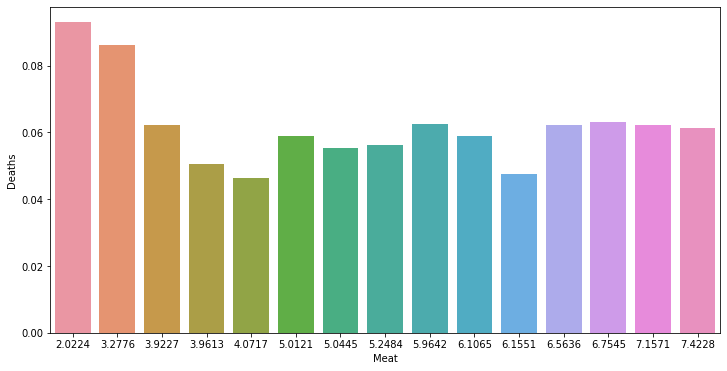
The figure shows a high death rate ratio for countries with low meat consumption and recovery rates. Therefore, the figure debunks the doubt about meat consumption and COVID-19 deaths.
A key takeaway point for entities looking to improve nutrition patterns in respective regions, such as the NHS trust, was adopting the eating patterns in countries with higher recovery rates and lower COVID-19 cases. For this assessment, the focus was on the maximum food calories for the said countries. There is an assumption that vegetable products are characterized by lower COVID-19 cases and high recovery rates, while animal products translate to lower recovery rates and increased COVID-19 cases (Moreb et al., 2021). The following figure illustrates the comparison between vegetable products and animal products. Based on the mean analysis between different food types, it was evident that vegetable products have higher calorie values. This means that countries with lower COVID-19 cases and higher recovery rates embrace vegetable intake as it protects the citizens from contracting the virus.

To explain the influence of obesity on COVID-19, the focus was first put on the role of sugary foods (sugars and sweeteners) and the percentage of obese citizens in nations with higher obesity rates. The following figure illustrates these findings.

There is a direct relationship between obesity and the consumption of sugary products. However, these figures only include data obtained from higher-obesity nations where the lower value was 30%. Another important observation is a disproportionate trend between obesity rates and COVID-19 mortality rates. For instance, Kiribati had the highest obesity (45.60), and Belgium had the highest Deaths (0.09). To satisfy the assumption of COVID-19 deaths based on obesity levels would have seen Kiribati leading in death rate instead of Belgium. However, this assumption is still evident since the data estimates are based on the population. Therefore, the data is influenced by population size, where a small size would portray a significant percentage compared to a larger population.
Evaluation
In this report, data analysis has provided exhaustive data to determine the covariate impact on the marginal mean of COVID-19 outcomes. This analysis is in line with the aim of the study and recommendations for the NHS trust to introduce satisfactory diet patterns to the region of focus. Findings show that countries that consume more eggs, cereals, spices, and stimulants have higher COVID-19 recovery rates and lower deaths. In contrast, those consuming meat, sugary, vegetal products, and animal fats had lower recovery rates and increased deaths. Conclusive information is present in the following figures.
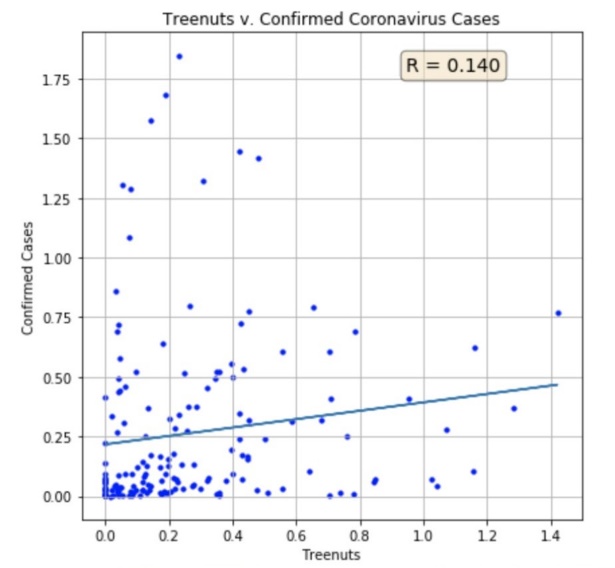

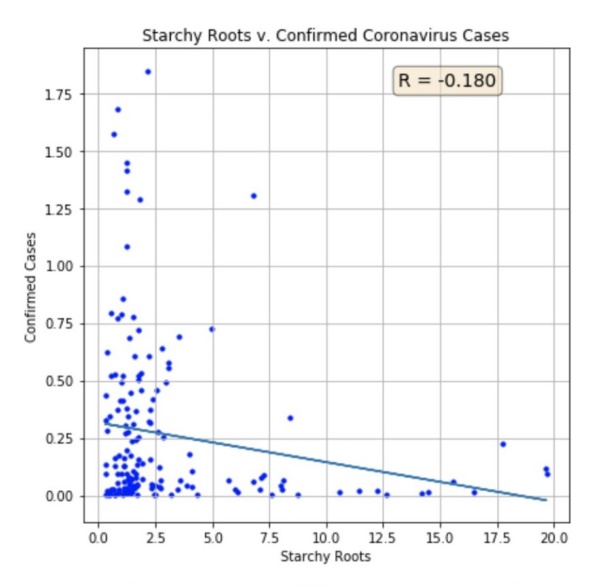

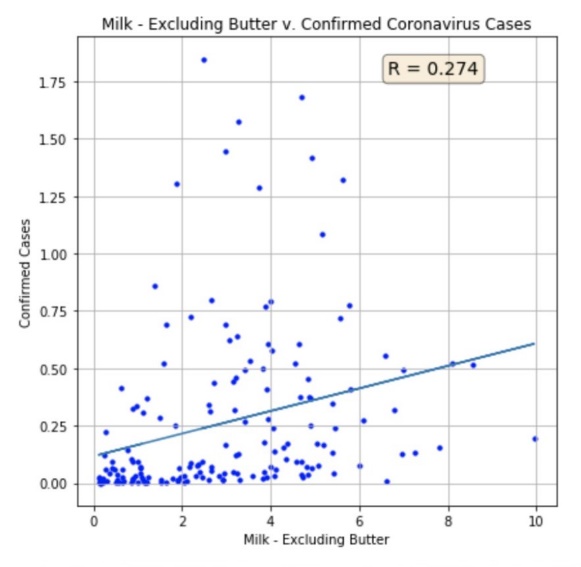
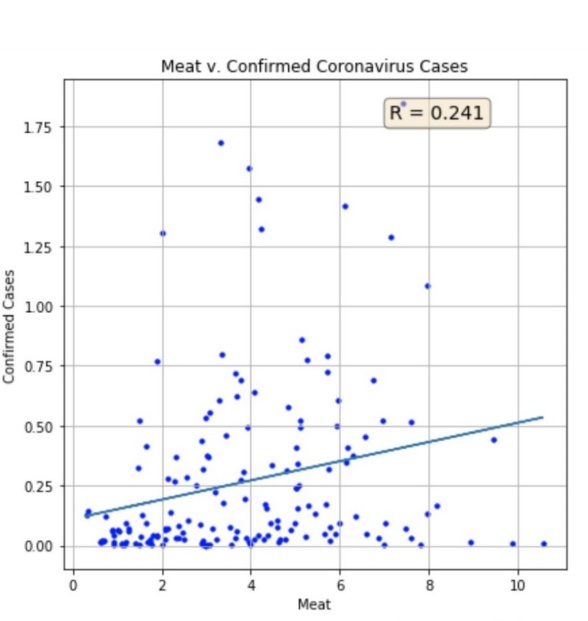


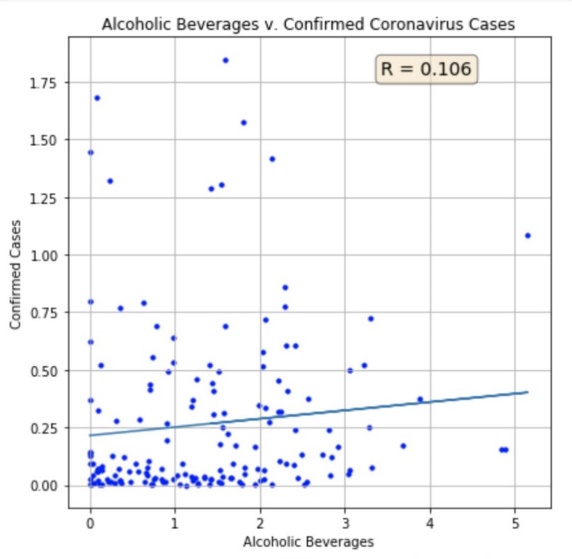
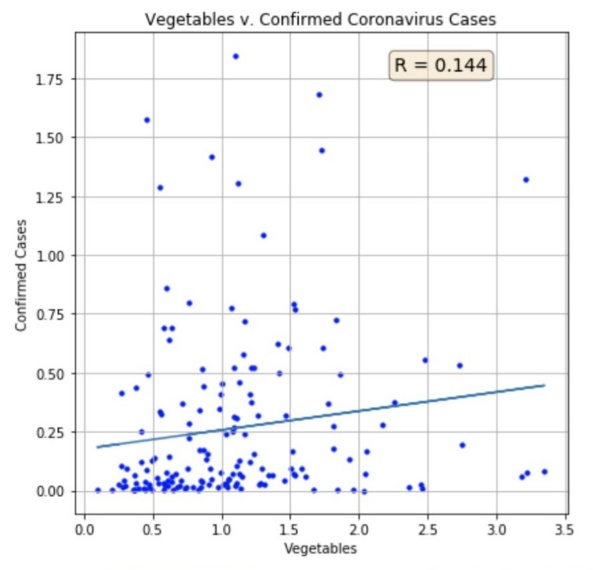
The current report satisfies the hypotheses and verifies the assumptions regarding nutrition trends and COVID-19 outcomes. The NHS trust needs to identify the importance of healthy nutrition patterns to reduce COVID-19 deaths. This is especially evident due to the impact of good nutrition on reducing the prevalence of chronic diseases. However, this does not suggest that the trust recommends good nutrition to remedy COVID-19. These recommendations are only interventions to help people reduce the risks of contracting the virus or manage their health to prevent the onset of chronic conditions that translate to negative outcomes such as death. Proper nutrition should also be accompanied by other balanced energy and physical activity to boost metabolism. Failure to participate in such actions may result in the concentration of surplus energy, leading to overweight and obesity. Although the study fails to establish a connection between obesity and COVID-19 deaths, it should not be overlooked since previous studies have associated lack of physical activity with increased chronic conditions worsening COVID-19 impact (de Siqueira et al., 2020; Dietz and Santos-Burgoa, 2020).
The NHS trust needs to increase awareness of proper nutritional guidelines to reduce or control COVID-19 mortality rates while also emphasizing the importance of the physical activity to reduce the risk of obesity. Zhang and Liu (2020) found that nutrition measures, such as introducing minerals, immune-enhancers, and vitamins to patients with respiratory and infectious diseases, would greatly enhance their body’s response to COVID-19 positively. The NHS trust should embrace the same assumption since it aims to reduce COVID-19 deaths. Another important consideration is understanding individual differences such as age to determine the best nutritional and physical activity routine for engagement. Different groups have different requirements based on age and underlying complications. Therefore, the trust should implement different nutritional statuses for different individuals after evaluating their conditions and their medications (if any).
The report’s findings are in line with the trust’s goal as they present the entity with the right information, such as the introduction of diet groups and patterns that would reduce COVID-19 deaths.
Steps for Future Deployment
The effectiveness of current recommendations is based on further research and understanding of COVID-19 risk factors leading to increased mortality rates. The current report fails to illustrate a connection between obesity and mortality rates which poses a challenge to the study in presenting a connection, positive or negative. Therefore, the current information is incomplete without illustrating COVID-19 deaths based on the risk factors. Future deployment should also focus on critically understanding the impact of specific food types on COVID-19 outcomes and assessing which food groups are attributed to various outcomes. The current report only presents a generalized outlook of said food groups and slight outcomes such as deaths and recoveries. Additionally, the role of malnourishment has not been evaluated, meaning that this factor cannot be used to explain COVID-19 outcomes. Future studies should also find comprehensive data illustrating the role of malnutrition on COVID-19 outcomes.
Conclusion
The report examines the role of nutrition in reducing COVID-19 deaths to provide the NHS trust with viable measures and recommendations to implement. The findings reveal that some food groups such as eggs, cereals, spices, and stimulants are attributed to lower COVID-19 deaths and increased recovery rates. At the same time, some groups, including meat and sugary products, are attributed to increased death rates and lower recovery rates. Despite numerous studies highlighting the role of obesity on COVID-19 mortality, the report fails to establish a relationship that paves the way for further work. This limitation can be due to the data cleaning process, which altered some data and replaced existent values to simplify analysis. Dietary differences also illustrate that there are varying COVID-19 outcomes.
Additionally, studying global trends, including unbalanced diet and dietary patterns, present a detailed understanding of the role of diet on COVID-19 outcomes. Such recommendations are viable for the NHS trust to introduce measures to reduce COVID-19 deaths. Applying these recommendations and current interventions would help the NHS trust improve patient outcomes. This success depends on how well the trust recognizes the role of diet to determine effective nutrition. Afterwards, the entity can focus on implementing programs and policies addressing the need to adapt or replace current diets patterns based on how well one nation is performing.
Reference List
Bruins, M.J., Van Dael, P. and Eggersdorfer, M., 2019. The role of nutrients in reducing the risk for noncommunicable diseases during aging. Nutrients, 11(1), p.85.
Butler, M.J. and Barrientos, R.M., 2020. The impact of nutrition on COVID-19 susceptibility and long-term consequences. Brain, Behavior, and Immunity, 87, pp.53-54.
Caccialanza, R., Laviano, A., Lobascio, F., Montagna, E., Bruno, R., Ludovisi, S., Corsico, A., Di Sabatino, A., Belliato, M., Calvi, M., Iacona, I., Grugnetti, G., Bonadeo, E., Muzzi, A. and Cereda, E., 2020. Early nutritional supplementation in non-critically ill patients hospitalized for the 2019 novel coronavirus disease (COVID-19): Rationale and feasibility of a shared pragmatic protocol. Nutrition, 74, p.110835.
Dalton, J., 2022. Meat-eating creates risk of future pandemic that ‘would make Covid seem a dress rehearsal’, scientists warn. [online] Web.
de Siqueira, J.V.V., Almeida, L.G., Zica, B.O., Brum, I.B., Barceló, A. and de Siqueira Galil, A.G., 2020. Impact of obesity on hospitalizations and mortality, due to COVID-19: A systematic review. Obesity research & clinical practice, 14(5), pp.398-403.
Dietz, W. and Santos-Burgoa, C., 2020. Obesity and its implications for COVID-19 mortality. Obesity, 28(6), p.1005.
Li, J., Chen, Z., Nie, Y., Ma, Y., Guo, Q. and Dai, X., 2020. Identification of symptoms prognostic of COVID-19 severity: Multivariate data analysis of a case series in Henan Province. Journal of Medical Internet Research, 22(6), p.e19636.
Moreb, N.A., Albandary, A., Jaiswal, S. and Jaiswal, A.K., 2021. Fruits and vegetables in the management of underlying Conditions for COVID-19 high-risk groups. Foods, 10(2), p.389.
Muscogiuri, G., Barrea, L., Savastano, S. and Colao, A., 2020. Nutritional recommendations for COVID-19 quarantine. European Journal of Clinical Nutrition, 74(6), pp.850-851.
Osama, T., Pankhania, B. and Majeed, A., 2020. Protecting older people from COVID-19: Should the United Kingdom start at age 60?. Journal of the Royal Society of Medicine, 113(5), pp.169-170.
Sahoo, K., Samal, A.K., Pramanik, J. and Pani, S.K., 2019. Exploratory data analysis using Python. International Journal of Innovative Technology and Exploring Engineering (IJITEE), 8(12), p.2019.
Zhang, L. and Liu, Y., 2020. Potential interventions for novel coronavirus in China: A systematic review. Journal of Medical Virology, 92(5), pp.479-490.